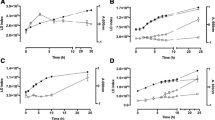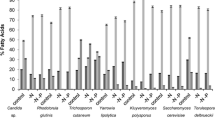Abstract
Microdroplets in the hyphae of Ashbya gossypii were found to become stained by Nile red. Purification of the stainable substance showed that the yellow fluorescent bodies consisted of triacylglycerol. During growth on glucose as the carbon source 8%–12% of the mycelial dry weight was found to be neutral lipid. When glucose declined in the medium, the content decreased to 3%–4% and the respiration quotient shifted to 0.6 indicating a reserve function of the fat. The fatty acid composition of the storage lipid was found to be strongly influenced by the carbon source. Mycelia cultivated on glucose contained 5% linoleic acid and 20% palmitoleic acid in their neutral fat while linoleic acid made up 54% and palmitoleic acid was not detectable (< 0.1%) in soybean-oil-grown mycelia. When plant oil was given as the sole carbon source, the fatty acid composition of the storage lipid showed a high similarity to the fed fat. 14C-labelled free oleic acid added to a culture growing on soybean oil was immediately incorporated into the fungal lipid. A pulse of 0.9 g/l free palmitoleic acid, fed during growth on olive oil, increased the content of this particular fatty acid in the fungal triacylglycerol from 0.8% to 9.6%. In addition, a liberation of free fatty acid and diacylglyceride was found in the culture supernatant when pure triolein was given as the sole carbon source. Obviously, the fungus cleaved the lipid serving as the carbon source extracellularly and used the liberated fatty acids for its storage lipid formation.
Similar content being viewed by others
References
Bacher A (1990) Biosynthesis of flavins. In: Müller F (ed) Chemistry and biochemistry of flavoenzymes, vol I. CRC, Boca Raton, Ann Arbor, Boston
Batra LR (1973) Nematosporaceae (Hemiascomycetidae): taxonomy, pathogenicity, distribution, and vector relations. USDA Technol Bull 1469:1–71
Batra LR, Batra SWT (1985) Floral mimicry induced by mummy-berry fungus exploits host's pollinators as vectors. Science 228:1011–1013
Bigelis R (1989) Industrial products of biotechnology: application of gene technology. In: Rehm HJ, Reed G (eds) Biotechnology, vol 7b. VCH, Weinheim, p 243
Blumenthal HJ (1976) Reserve carbohydrates in fungi. In: Smith JE, Berry DR (eds) The filamentous fungi, vol 2. Academic Press, London, pp 229–307
Dammer KH, Ravelo HG (1990) Verseuchung von Leptoglossus gonagra (Fabr.) mit Nematospora coryli Peglion und Ashbya gossypii (Ashby et Nowell) Guilliermond in einer Zitrusanlage der Republik Kuba. Arch Phytopathol Pflazenschutz 26:71–78
Demain AL (1972) Riboflavin oversynthesis. Annu Rev Microbiol 26:369–388
Greenspan P, Mayer EP, Fowler SD (1985) Nile red: a selective fluorescent stain for intracellular lipid droplets. J Cell Biol 100:965–973
Guilliermond P (1928) Recherches sur quelques Ascomycetes inferieurs isoles de la stigmatomycose des graines de cotonnier. Essai sur la phylogenie des Ascomycetes. Rev Gen Bot 40:328–342, 397–414, 474–485, 555–574, 606–624, 690–704
Hanson AM (1967) Microbial production of pigments and vitamins. In: Peppler HJ (ed) Microbial technology. Reinhold, New York, pp 222–250
Iwai M, Tsujisaka Y (1974) The purification and the properties of three kinds of lipases from Rhizopus delemer. Agric Biol Chem 38:1241–1247
Kates M (1982) Techniques of lipidology: isolation, analysis and identification of lipids. In: Work TS, Work E (eds) Laboratory techniques in biochenistry and molecular biology. North-Holland, Amsterdam, Oxford
Khan AW, Walker TK (1961) Fat production from cane molasses by Penicillium spinulosum: a study on substances in cane molasses interfering with fat production. Can J Microbiol 7:895–899
Kouker G, Jaeger KE (1987) Specific and sensitive plate assay for bacterial lipases. Appl Environ Microbiol 53:211–213
Lago BD, Kaplan L (1981) Vitamin fermentations: B2 and B12. Adv Biotechnol 3:241–246
Lazar G, Schröder FR (1992) Degradation of lipids by fungi. In: Winkelmann G (ed) Microbial degradation of natural products. Chemie, Weinheim, pp 267–291
Lösel DM (1988) Fungal lipids. In: Ratledge C, Wilkinson SG (eds) Microbial lipids. Academic Press, London, pp 699–806
MacLaren JA (1952) The effects of certain purines and pyrimidines upon the production of riboflavin by Eremothecium ashbyii. J Bacteriol 63:233–241
Makarow M (1985) Endocytosis in Saccharomyces cerevisiae: internalization of α-amylase and fluorescent dextran into cells. EMBO 4:1861–1866
Metha SU, Mattoo AK, Modi VV (1972) Ribitol and flavinogenesis in Eremothecium ashbyii. Biochem J 130:159–166
Mukerji KG (1968) C.M.I. Descriptions of pathogenic fungi and bacteria No. 185. Commonwealth Agricultural Bureaux. The Eastern Press, London
Ösbas T, Kutsal T (1986) Comparative study of riboflavin production from two microorganisms: Eremothecium ashbyii and Ashbya gossypii. Enzyme Microb Technol 8:593–596
Peled N, Krenz MC (1981) A new assay of microbial lipases with emulsified trioleoylglycerol. Anal Biochem 112:219–222
Radin NS (1981) Extraction of tissue lipids with a solvent of low toxicity. In: Lowenstein (ed) Methods Enzymol 72:5–7
Rapp P, Backhaus S (1992) Formation of extracellular lipases by filamentous fungi, yeasts, and bacteria. Enzyme Microb Technol 14:938–943
Raths S, Rohrer J, Crausaz F, Riezman H (1993) end3 and end4: two mutants defective in receptor-mediated and fluid-phase endocytosis in Saccharomyces cerevisiae J Cell Biol 120:55–65
Ratledge C (1982) Microbial oils and fats: an assessment of their commercial potential. Progress Industrial Microbiol 16:119–206
Ratledge C (1988) Oils and fats: production, degradation and utilization by yeast. In: Verachtert H, Mot RD (eds) Yeast, biotechnology and biocatalysis, Dekker, New York, pp 223–253
Stahmann KP, Pielken P, Schimz KL, Sahm H (1992) Degradation of extracellular β-(1,3)(1,6)-D-Glucan by Botrytis cinerea. Appl Environ Microbiol 58:3347–3354
Thevelein JM (1984) Regulation of trehalose metabolism in fungi. Microbiol Rev 48:42–59
Umbreit WW (1964) Manometric techniques. Burgess, Minneapolis
Volk R, Bacher A (1990) Studies on the 4-carbon precursor in the biosynthesis of riboflavin. J Biol Chem 265:19479–19485
Weber DJ (1980) Lipid metabolism during fungal development. In: Weete JD (ed) Lipid biochemistry of fungi and other organisms. Plenum, New York, London, pp 300–325
Weete JD (1980) Lipid biochemistry of fungi and other organisms. Plenum, New York, London
Wickerham LJ, Flickinger MH, Johnsten RM (1946) The production of riboflavin by Ashbya gossypii. Arch Biochem 9:95–98
Winkler UK, Stuckmann M (1979) Glycogen, hyaluronate, and some other polysaccharides greatly enhance the formation of exolipase by Serratia marcescens. J Bacteriol 138:663–670
Author information
Authors and Affiliations
Additional information
This paper is dedicated to Prof. Dr. F. Wagner on the occasion of his 65th birthday
Rights and permissions
About this article
Cite this article
Stahmann, KP., Kupp, C., Feldmann, S.D. et al. Formation and degradation of lipid bodies found in the riboflavin-producing fungus Ashbya gossypii . Appl Microbiol Biotechnol 42, 121–127 (1994). https://doi.org/10.1007/BF00170234
Received:
Revised:
Accepted:
Issue Date:
DOI: https://doi.org/10.1007/BF00170234




